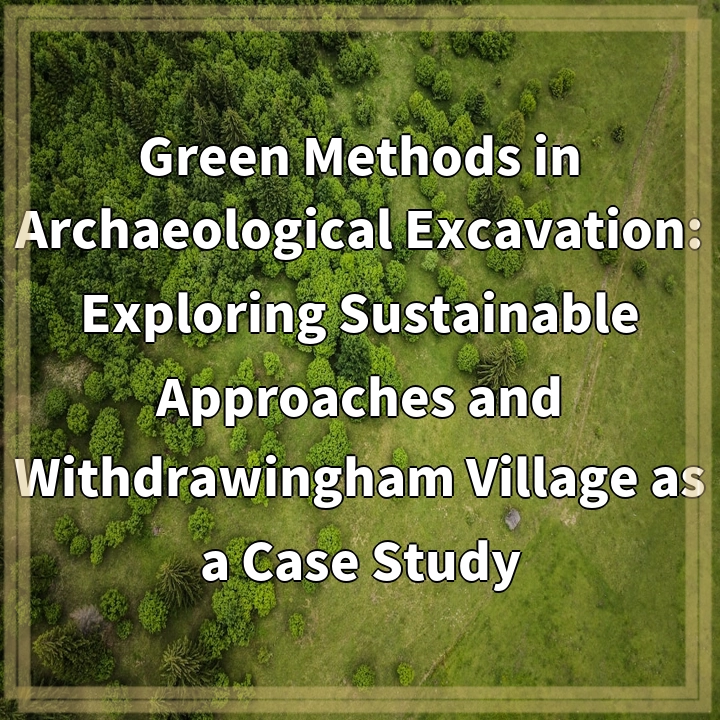
What is Green Methods in Archaeological Excavation?
Green methods in archaeological excavation refer to the adoption of sustainable and environmentally-friendly practices during the process of uncovering and analyzing historical sites. Traditional excavation methods often involve significant environmental impact through the use of heavy machinery, excessive fuel consumption, and disregard for conservation principles. In response to these concerns, archaeologists have increasingly recognized the importance of integrating green methods to reduce their ecological footprint and contribute to the overall sustainability of archaeological projects.
Real-World Problems Associated with Green Methods in Archaeological Excavation
While green methods in archaeological excavation offer numerous benefits, they also face some real-world challenges and limitations. It is important to acknowledge and address these problems to ensure the successful implementation of sustainable approaches in archaeological practices.
Lack of awareness and resistance to change
One of the main hurdles is the lack of awareness and resistance to change within the archaeological community. Many archaeologists are accustomed to conventional excavation techniques and may be hesitant to adopt new methods. Overcoming this resistance requires educational initiatives, peer collaboration, and the dissemination of success stories showcasing the tangible benefits of green excavation practices.
Site-specific constraints
Each archaeological site presents unique challenges and constraints that may limit the applicability of green methods. Factors such as site sensitivity, geological conditions, and the presence of delicate artifacts or structures can impact the feasibility of certain sustainable practices. Archaeologists need to carefully evaluate the site-specific factors and develop tailored solutions accordingly.
Budgetary limitations
Green methods often require additional resources, such as specialized equipment or trained personnel, which can incur higher costs compared to traditional excavation techniques. Budgetary constraints may hinder the widespread implementation of sustainable approaches. To address this challenge, funding agencies and archaeologists need to collaborate to secure adequate financial support for green excavation initiatives.
Regulatory and legal considerations
Varying regulatory frameworks and legal requirements in different countries or regions can pose challenges for implementing green methods in archaeological excavation. Compliance with these regulations, obtaining necessary permits, and navigating bureaucratic processes can be time-consuming and complex. Ensuring streamlined procedures and standardized guidelines can facilitate the integration of sustainable practices.

Solutions for Green Methods in Archaeological Excavation
To overcome the challenges associated with implementing green methods in archaeological excavation, several solutions can be explored. By addressing these solutions, archaeologists can effectively adopt sustainable approaches and contribute to the conservation and preservation of historical sites.
Increasing awareness and education
Educating the archaeological community about the benefits and importance of green methods is crucial. This can be achieved through workshops, conferences, and training sessions that highlight successful case studies and provide practical guidance for implementing sustainable practices. Collaboration with academic institutions and professional organizations can also play a vital role in promoting awareness and education.
Developing site-specific strategies
Recognizing the unique challenges of each archaeological site, it is necessary to develop tailored and site-specific strategies for implementing green methods. Conducting thorough assessments prior to excavation, involving multidisciplinary teams, and considering local environmental and cultural factors will help ensure the success and feasibility of sustainable approaches.
Securing funding and resources
To overcome budgetary limitations, archaeologists can actively seek funding opportunities and partnerships with governmental agencies, non-profit organizations, and private foundations that prioritize sustainability in archaeological projects. Collaborative efforts can help secure the necessary financial resources, specialized equipment, and trained personnel required for the implementation of green excavation methods.
Advocating for supportive policies
Archaeologists, along with relevant stakeholders, should advocate for supportive policies and regulations that promote the integration of green excavation methods. Engaging with policymakers, conducting studies on the long-term benefits of sustainable practices, and participating in public consultations can help shape regulations that facilitate the adoption of environmentally-friendly approaches in archaeological excavation.















